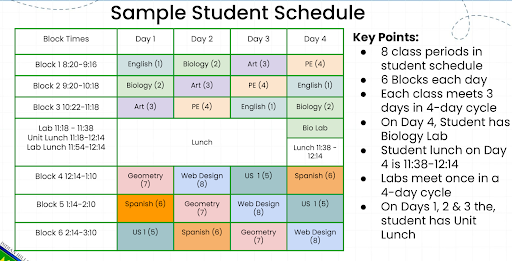
On November 21, Superintendent Shauna DeMarco gave a virtual presentation via Zoom about the proposed plan for block scheduling, which was presented to the Board of Ed the following Monday. On December 16, the Board of Ed voted and approved the plan to be effective for the ‘25-’26 school year.
The Basics of the Schedule:
The typical day with block scheduling will start at 8:20 A.M., although the school will be open at 7:15A.M. for those who need to be dropped off earlier, and end at 3:10 P.M.. Each student will have 8 class periods, but only 6 will meet per day. There will be three 56 minute class periods in the morning, followed by a 56 minute unit lunch, and three 56 minute classes in the afternoon. As a result, one class will be dropped in the morning, and another class will be dropped in the afternoon. Drops will run on a 4 day cycle, labeled “1 day”, “2 day”, “3 day”, and “4 day”. The district is hoping to make it more clear as to which “day” it is, as snow days and holidays can make the rotation confusing.
This schedule change will be addressed when planning the schedules for next school year, as Mrs. Perry explained, “I think it is really helpful for students to explore the sample schedules available to see how there will be a set elective schedule, allowing for more structure.” Students and their counselors will be given handouts of these schedules to fill out during the February scheduling conference.
The Effects on Academics:
With this schedule change, some classes will be more impacted than others. For instance, music classes will only be offered for 5 credits, as it is unfeasible to only have students practice and perform for half a year. According to orchestra and choir director Mrs. Reitter, “The music department at both schools is concerned about having our 2.5 credit option no longer be viable. Most of our students are committed to taking their ensembles every day, but some are feeling the pressure of credit limits.” Mrs. Davidson, District Supervisor of Music, agreed. “While transitioning to full-year music courses may present some initial challenges, I strongly believe it will ultimately strengthen the music program and provide better support for our students who are passionate about music and performing,” she emphasized.
Meanwhile, this is the second consecutive change that freshman English classes have seen. For the ‘23-’24 school year, freshman English classes were reduced from 7.5 credits to 5 credits plus a co-requisite of English Literacy Lab. This directly impacted the depth in which freshmen could examine and investigate the material. As a result, many are hopeful that these changes will be beneficial. English teacher Mrs. Loccke expressed, “I am looking forward to having students for almost an hour so we can dig in deeper to reading, analyzing literature, having productive discussions, and my favorite; offering more essay practice.”
The science classes will also be experiencing a significant change, as double lab periods will no longer be utilized. “This will impact the number of labs that can be completed, the amount of content that can be covered, and shift the style of teaching away from a student centered focus,” physics teacher Mr. Wadhams explained. “I cannot speak for others, but I know for me, I will need to do a complete overhaul of my teaching style.” Instead of a double period, science periods will cut into either the first 20 minutes or last 20 minutes of lunch once every rotation. For instance, if a student has science in the morning rotation, the day that science falls in the period 3 slot will be the day that science cuts into the first 20 minutes of lunch. Likewise, if a student has science in the afternoon, the day that science falls on period 4 will be the day that science cuts into the last 20 minutes of lunch. As the science classes will meet for less time, they will count as 6 credits instead of 7.5 (rih.org).
Unit Lunch and Open Campus:
As the schedule will allow for a unit lunch, students of all grades will be able to eat at the same time. This will allow students to see friends that they otherwise would not see in their classes. Moreover, a unit lunch holds much potential as clubs could possibly meet and extra help might be offered. As of yet, none of this has been solidified, but there is much talk of utilizing the unit lunch for academic and extracurricular advantage. In addition, the food service will have to be adapted to accommodate the school. Having the lab periods cut into lunch will be beneficial as it will stagger the flow of students, but there are many more changes to come.
Some of these changes include an open campus. This will be a senior privilege, open to those who maintain at least a C in their classes, have strong attendance and timeliness, have parental approval, and abide by the rules. Current junior Kayla Ilie commented, “I believe that these requirements for the privilege are fair, and I am looking forward to leaving during lunch!” Open campus will allow students to leave campus during lunch and study halls. Due to the rotating block, this means that seniors may be able to leave early, arrive late, or have an extended lunch period on the other days. The district is planning on collaborating with local businesses in order to ensure that open campus will be effective, especially for meal purposes (rih.org).
Timing Changes:
Minimum days will serve as “anchor days,” as all eight classes will meet for 27 minutes. The unit lunch will be removed to allow for more time to be allotted to the classes. Each class will run 2 minutes longer than the current period on a minimum day. As a result, class time can be more effectively used. Moreover, days will start at 8:20 A.M. and end at 12:24 P.M. for a total of 4 hours and 4 minutes. This is 12 minutes shorter than the current minimum day, which starts at 7:35 and ends at 11:51 for a total of 4 hours and 16 minutes.
Moreover, the total amount of time that classes meet per year is only 9 minutes less with block scheduling. Therefore, it is reasonable to infer that the amount of material that is able to be covered will be the same. In addition, in order to ensure more consistency in electives, 2.5 credit classes will meet for either the first two quarters or last two quarters of the school year. This change may be especially beneficial for athletes. For instance, if a student plays a spring sport and knows that their schedule gets very busy in the second half of the school year, they can take a 2.5 credit course for the first half of the year and take a study hall for the second half (rih.org).
Furthermore, the work study program will still be implemented, even with the rotating schedule. Dismissal times may be staggered, as far as how early a student may be excused, but ultimately the program will still be in effect.
Why are we changing the schedule:
The district has approved these scheduling changes with the hope that they will improve the well-being of students. Academically, students may be more engaged in their classes, as the times that classes meet will be rotated and students are generally more attentive at different times of the day. In addition, it makes school less mundane, as students can expect a different routine each day. Moreover, teachers have 13 extra minutes each class period, allowing for more time to conduct engaging activities. This is also beneficial for special education students, who can receive more time and attention from their teachers. Generally, teachers are “cautiously optimistic” of the changes, as they are hoping to see more student engagement, while also acknowledging that with every change comes adjustments.
Socially, students will be able to see more people, as one will pass more people in the hallways as the classes and routes change each day in the cycle and the unit lunch allows for students to interact with more people. In addition, students’ stress levels will likely decrease as there will be six classes, instead of eight, to prepare for the next day. Likewise, if students have sports games or other commitments that take them out of school early, they will not always be missing the same class (rih.org).
Perhaps most importantly, the later start time will allow students to get better sleep. Teens get their most effective sleep later at night. In addition, it is recommended that teens get 8.5-9.5 hours of sleep per night, but in a poll conducted by the National Sleep Foundation, only 13% of United States high school students were meeting the recommended hours (American Academy of Pediatrics). By starting school later, the district is hoping to see improvements in energy, mood, mental health, safe driving, academic grades, and participation.





